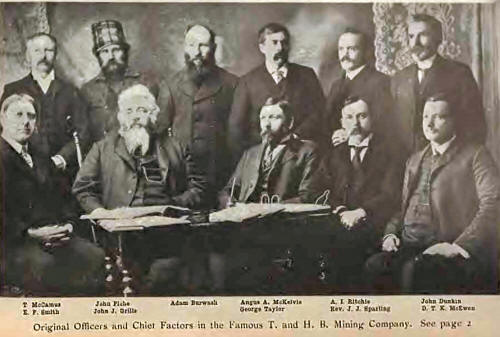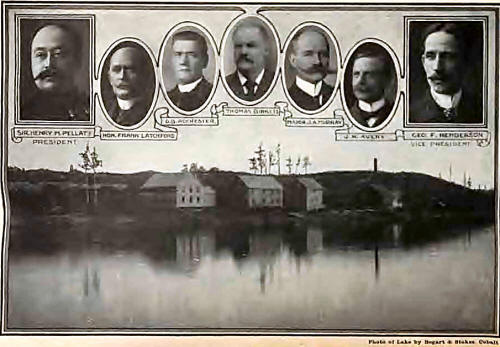|
WE will begin right
where we sit to talk of the real mines. It will be like talking of the
folks down home, since it may be called a home mine—so many Ottawans are
there in it.
I have never before
noted the absolute necessity of a company being run with scrupulously
honest care as since coming to Cobalt. An honest, wise and careful
directorate can take a mining property, which had been passed over by
hundreds of prospectors, and bring it out one of the great successes of
the camp, whilst a first choice may be purposely managed to death.
Not until the latter
part of 1906 was the lake that lies along the east side of built-up
Cobalt looked upon as of enough value to stake, while prospectors had
gone miles away to take up claims which have long since been abandoned
as of no value. When Cobalt Lake was offered for sale by the Government,
it dawned upon so many that beneath its waters lay a vast deposit of
silver, that $1,085,000 were bid for it, and that too by some of the
best business men in the country, who figured that with the greatest
mines in the district surrounding it, this deep basin must contain
fabulous wealth. Others said: “It may contain silver, but lying beneath
a deep lake, it will not pay to go after it.” These latter had not taken
into account the men at the head of the purchasing company. Men are they
to whom the difficulties of the “others” are but ordinary business
propositions. And so it is being proved. They chose a-manager who knew
but to accomplish, and a mining engineer to whom the sinking and
drifting under a lake was a simple thing.
Depth of Cobalt Lake
The first thing to do
was to find the depth of the lake and the formation of the bottom. This
they learned and made a chart of it. This chart shows the depth for
every 66 feet to be about forty feet of water, and a deposit of about
the same down to the bed rock.
Having a shore line
extending back 33 feet from high water mark, they began sinking shafts,
first by hand and later by the most approved machinery; with compressed
air power for driving the drills, they have sunk one after another until
they have now started on the seventh shaft. These, in their order, have
reached 20, 48, 20, 162, 100, 106, 20 feet, and north shaft 70.
Having sunk, they
purpose drifting and making a network of tunnels all throughout—far
below the bottom of the lake, just as though it were but ordinary
ground. From shaft No. 6 they will go under the south end of the lake,
to catch theTvalu-able veins known to run out from the McKinley-Daxragh
mines, and by tunnels connect the other shafts, catching veins on the
way.
They Have Found It
The “Others” said: “We
could have had that lake, but we did not want it.” They would like to
have it now! Yes, they are honest enough to admit their error. And why
not? Even while getting ready to mine, so much silver has been dug that
the value has been proved, and yet the great ore bed has scarce been
touched.
The Indians Knew
Long years ago the
Indians used to tell how that they found their silver trinkets beneath
the water. They would never say where that water lay. They had a
superstition that misfortune would follow should they give its hiding
place. From the casual description given by wandering bands, many think
that Cobalt's


location was known to
them, and doubtless from this very lake’s borders came many of those
trinkets, for scarce had the company begun work along the east shore
when silver was found.
A Diversion of the Camp
Last winter, I am told,
it was one of the diversions of Cobalt to cross on the ice, every few
days, to see some new find made by the company, as the work went merrily
along. Among the finds are fine samples of “wire” silver that are
beautiful enough to enthuse the breast of other than an Indian. But what
is a greater proof of a body of ore, lying far beneath the lake, is the
continual finding of great masses of melted silver, as though in the
aeons ago, this metal, having filled the surrounding crevices, had
poured in residue into this deep depression, from which a wise
engineering skill is to wrest it for the enrichment of those whose faith
is strong enough to await the proof.
Cobalt Lake Mining; Co.
Officers
The officials of the
Company are the following: President, Sir Henry M. Pellatt, of Toronto;
Vice-President, George F. Henderson, of Ottawa; Secretary-Treasurer, G.
F. Morrison, Toronto. Directors: Hon. Frank Latchford; Thomas Birkett,
ex-M.P.; Gordon C. Edwards; D. B. Rochester, Managing Director (all of
Ottawa); '.Britton Osier, and Major J. A. Murray, of Toronto; and J. H.
Avery, of Detroit, Mich. Engineer in charge of work, E. L. Fralick,
Belleville.
The Plant
The Cobalt Lake have
one of the most complete plants in the district. The buildings are large
and well built. These are an office, dining-room and kitchen, bunk-house
that would be a good model for many a hotel. In the spacious power-house
are two 100 horse-power boilers, a 15-drill air compressor, from which
run out pipes to convey the air to all parts of the mines. A private
electric light plant furnishes light to the buildings and mines.
History of the Mine
When Cobalt’s history
shall have been written, no chapter will compare in uniqueness with that
of the Cobalt Lake Company. See the rapidity of its formation. On
November 22nd, 1906, the first official announcement was made by the
Government that the lake would be sold, and that the tenders would close
on December 20th,—less than one month away. There was no time for any
sort of an organization among capitalists, so a popular syndicate was
formed and when the subscription lists were collected it was found that
almost 700 had subscribed an average of about $1,800 each—the larger
number, of Ottawans. At the first meeting of the subscribers, Messrs.
Geo. F. Henderson, Thomas Birkett and D. B. Rochester were appointed to
deal with the matter, the last-named of whom had been active from the
start, having long known of the property. These gentlemen went to
Toronto, where several hundred thousand dollars had been subscribed. At
a conference with Sir Henry Pellatt and Britton Osier, the two
syndicates were united, and the amount thought to be necessary to bid in
order to secure the property was decided by each of the conferees
writing an amount upon a slip of paper. When these slips were collected
and an average struck, the sum was found to be $1,085,000, which was bid
and the lake secured.
The company was quickly
formed, capitalized at $5,000,000, of which $4 ,000,000 was to be issued
at once, and each subscriber given three shares for each dollar of his
subscription. It was decided to issue $400,000 of treasury stock for
development work and other necessary purposes. Most of this was taken up
at 85 cents a share by the members of the syndicate. To do this, not a
line of advertisement was necessary.
When the 85 cents were
bid, it was all a vague prospect— now, months after, when the property
is showing greater values than were looked for, the stock has dropped to
a point so far below, that to buy at present prices is like gathering
money in with a shovel. Remember, as you read this a few months hence,
that “I told you so.” I speak with all confidence, fori have gone down
to see.
Later.—No. 4 shaft,
that started in nicolite, has run into native silver, showing up to 925
oz. The first shipment has just been made (Jan. 1908). It was 50,828
lbs. of high grade ore. |
